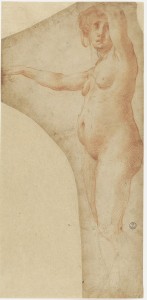Florence, Uffizi, no. 6478F.
Red chalk over faint outlines in black chalk, 36.7 x 17.7, irregularly cut; laid down; wm.?
LITERATURE:
Berenson, 1903, no. 2410, as Rosso.
Ferri, 1917, no. 19, as Rosso.
Leoporini, Die Kunstlerzeichnung, 1928, 269, Pl. 136, as Rosso.
Kusenberg, 1931, 135, 140, no. 18, as Rosso, around 1521-1523.
Berenson, 1938, no. 2410, as Rosso.
Barocchi, 1950, 193-194, 223, Fig. 160, as Rosso, around 1523, the so-called Incinta; related to Dürer.
Bologna and Causa, 1952, 59, as Rosso.
Bertini, BdA, 1952, 312, as Rosso.
Luisa Marcucci, in Mostra di disegni, 1954, 23, no. 32, as Rosso, around 1522-1523.
Ames, 1954, 99, Fig. 5, as Rosso, and as showing a physique probably intended to be unattractive.
Sinibaldi, 1960, 17, no. 85, as Rosso.
Berenson, 1961, no. 2410, as Rosso.
Carroll, 1961, 446, 447, Fig. 3, 449, as Rosso, around 1521.
Carroll, 1964 (1976), I, Bk. I, 64-69, 71, 76-77, 79-80, 82, 87-88, 95, 97, Bk. II, 213-215, D.9, II, Bk. III, Fig. 21, as Rosso, c. 1520.
Carroll, 1978, 25, 27, Fig. 4, 39, as Rosso, around 1520.
Forlani Tempesti, in Primato del disegno, 1980, 193, no. 458, as Rosso, c. 1522-1523.
Darragon, 1983, 33-34, Fig. 10, as c. 1520, and an idea of the nude contrary to Raphael’s ideal theory as in his Galatea.
Wilmes, 1985, 85.
Carroll, 1987, 39, 58-60, no. 3, with Fig., as Rosso, c. 1520.
Franklin, 1988, 326, No. 3, as not representing Eve because of her necklace [in response to my statement that it was unlikely, though not impossible, that it does].
Mundy, 1988, 79, with Fig., believes extended speculation on the purpose of this drawing is not necessary if Vasari’s story is correct that he drew from the model every day.
Leone de Castris, 1988, as Rosso, 1520s.
Franklin, 1994, 65-66, Pls. 47 and 49, as done around the time of the Volterra Deposition.
The traditional attribution of this drawing to Rosso has never been questioned. As it represents a nude woman the drawing is not wholly comparable with any other work by Rosso from the time around which the drawing seems to have been made. But the head of the woman with its large round and deeply set eyes, its straight nose, and small, partly opened mouth is very similar to several of the heads in Rosso’s Volterra Deposition (Fig.P.9a) and Marriage of the Virgin (Fig.P.13a). The draughtsmanship of the drawing—the contours, in places firmly drawn, in other places delicately varied; the shading rendered by fine, regular hatching that resembles the evenly chiseled surface of an unpolished piece of sculpture; and the sharp delineation of details—is virtually identical to that of Rosso’s study (Fig.D.7) for the figure of St. Sebastian in the Dei Altarpiece. Furthermore, the description of flickering light in these two drawings is extraordinarily alike. The draughtsmanship of the Standing Nude Woman is also extremely similar to that of Rosso’s Bacchus in a Niche in Besançon (Fig.D.18a) and Virtù Vanquishing Fortune in Darmstadt (Fig.D.6a). There can be no doubt that the Uffizi drawing is an autograph work by Rosso Fiorentino.
Although generally dated between 1521 and 1523 it is more probable that it was done slightly earlier, around 1520, when Rosso’s style would seem to have been most Pontormesque. Around 1519, in the Study for an Altarpiece (Fig.D.4) and in the Holy Family in Baltimore (Fig.P.7a), the influence of Pontormo is first clearly discernible, and to an extent that makes these works significantly different from the drawings and paintings that were done before them. By 1521, this influence was fully assimilated by Rosso, as visible in the Volterra and Villamagna pictures (Fig.P.9a; Fig.P.10a), but without any indication that in adopting aspects of Pontormo’s manner that Rosso had in these paintings given up his style. In Rosso’s later Florentine works Pontormo’s influence is only occasionally echoed in the shapes of the features of a head or in the swelling form of an arm.
Still, the Standing Nude Woman is so strikingly Pontormesque that she almost appears as the female counterpart to Pontormo’s St. Michael in Empoli of around 1519 (Fig.Pontormo, Empoli). The finely executed drawing in the Uffizi for the Saint’s leg (Fig.Pontormo, Florence, 6506F) may indicate, in its subtle fluctuating contours and closely hatched shading, a sharing of drawings with Rosso, also indicated in a bending figure in D.14, one of the St. Roch drawings of c. 1524.1 Rosso’s most Pontormesque moment would seem to have been around 1520, at which time this drawing should most probably be placed, along with the Portrait of a Young Man in Washington (Fig.P.8a).
1 See Proto Pisani, Rosana Caterina, in Il Pontormo a Empoli, Venice, 1994, pp. 105-108, no. 13, and pp. 1110-111, no. 16, for Ufizzi, n. 6506F recto.

